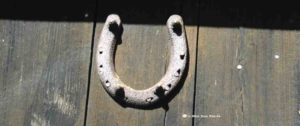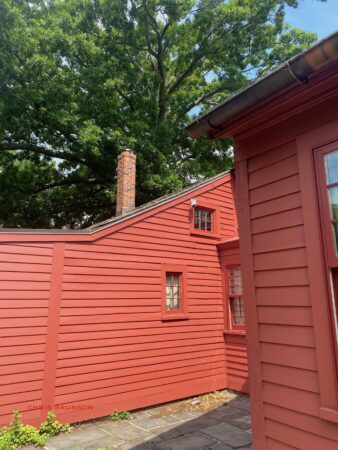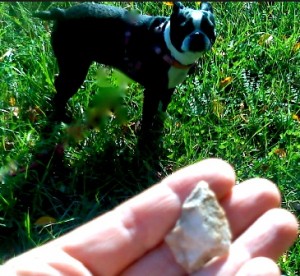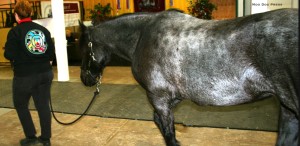Into The Archives: Three Structures, Time Travel, Sparks. Sikorsky
“Human creativity is the ultimate economic resource.” – Richard Florida
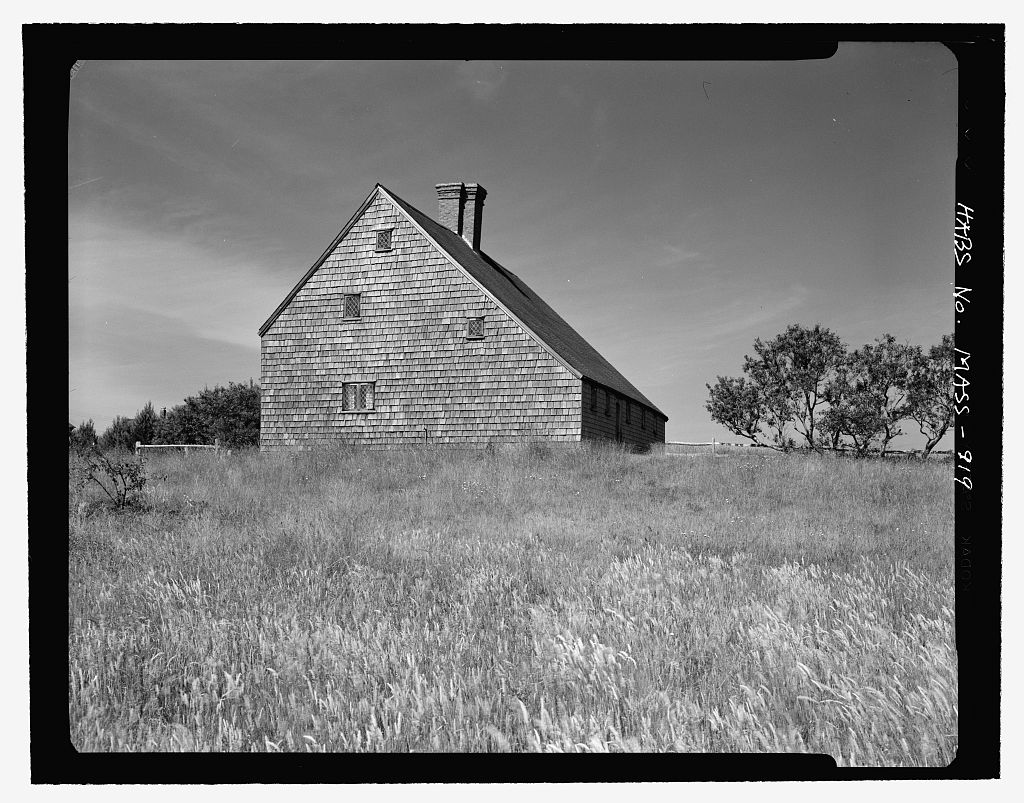
Into the archives, reading leads to discoveries. The oldest building on Nantucket Island, restored in 1927… Building/structure dates: 1686 Initial Construction. Historic American Buildings Survey Cortlandt V. D. Hubbard, Photographer June 1965. Jethro Coffin House, Sunset Hill, Nantucket, Nantucket County, MA.
Doors that will open from the inside, the human mind, ideas, a spark. Waiting. Connections, collections.
Structures viewed as engineered machines related to climate. A barn or tobacco shed is a machine of sorts which ventilation, air flow to dry and cure vegetative materials, provide shelter during the process. Old buildings also serve as community and economic assets for learning. Some are destinations with character, to house collections, archives. And there are those which also hold keys that unlock layers of understanding – the Jethro Coffin House, above. The Thomas Lee House in East Lyme. The Andrews Homestead of Meriden. Brush back time (and use some imagination) to “view” land holdings and understand placement, views. The difference in landscape now.
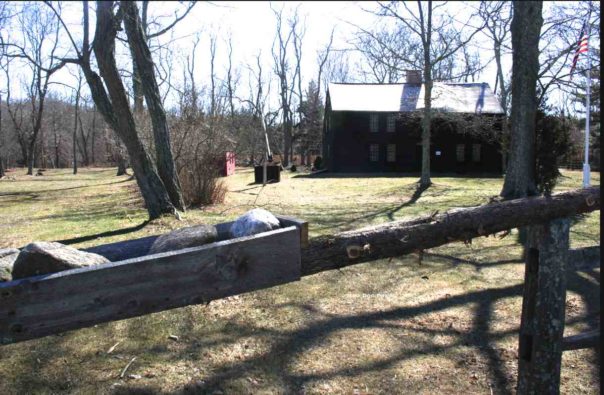
Thomas Lee House at the junction of Giant's Neck Road and Connecticut Route 156 in the Niantic section of East Lyme. Note the counterweight gate in the foreground. CB/MDP
The saltbox that can be seen from the road began as a one-room structure that originally faced south. What's past is present. It's right in front of you, though most people drive right by interesting places without really seeing them. Located just east of the popular Rocky Neck State Park, when the first stone was placed for a foundation here, the shore road (Route 156) did not exist.
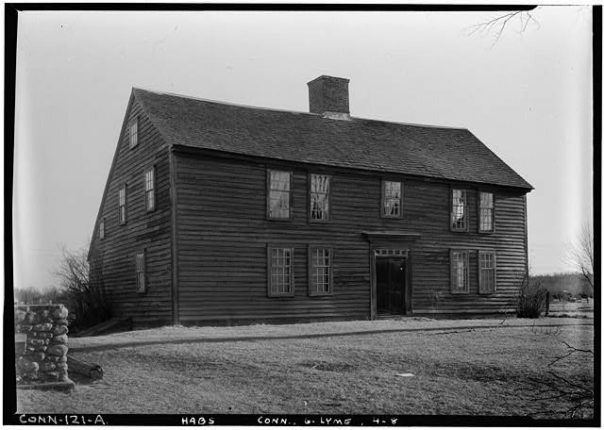
The Thomas Lee House in East Lyme, Connecticut. Source: Historic American Buildings Survey, Library of Congress.
After stopping to capture images of this place that has weathered centuries of life, thoughts about it percolated for days afterward. What the area was like when the (at first) simple home was first built? Erasing all that is manmade, thinking only of nature features such as streams, ocean, slope of terrain… the site for to build would be carefully chosen – more so then than nowadays. Plentiful water would be essential for life, cooking, cleaning, and the livestock that would be acquired later.
Since Native Americans already knew this region as home, a dwelling would serve many purposes, including for safety against perceived and real foes. To stay alive during winter meant keeping warm. Practical concerns to raise a family meant prepare meals, store necessary-to-life implements. Inland from the ocean would be good – but not too far since the sea also would be a plentiful food source. So a foothold was gained in what was then wilderness – 1660. This house stood to shelter a family that included 15 children more than a century before the USA was born.
Located at the junction of Giant's Neck Road and Route 156, East Lyme, Connecticut, the land includes the Little Boston Schoolhouse (1734) relocated here. There is also what looks like a privy nearby. A dormant garden (East Lyme Garden Club) in the back of the house is a more recent addition, earmarked for a re-visit during the growing season. Because of the efforts of dedicated people, the house still stands and is preserved by the members of the East Lyme Historical Society. The house is not far from what is called Bride Brook, a waterway native people knew as Sunkapaug.
Yes, there is a story behind the name – immortalized on a stone with a boulder and a plaque to recall a rather unusual wedding that took place in the winter of 1646-47. The story is that due to snowstorm, a magistrate who was to have performed the ceremony couldn't get there. So an ingenious solution because of jurisdiction came about – Governor Winthrop stood on one side to perform the ceremony, while the couple to be wed stood on the other to say their vows. So, Massachusetts Colony (Winthrop) and Connecticut (the couple wanting to be wed) with the brook flowing between as boundary; creative determination made it all work out. In modern times, descendants of the couple have revisited the site and been welcomed at the Thomas Lee House. Can you imagine?
Wipe away time to imagine the footings placed for a foundation, excavation and the resulting one room for survival. No communication links, a massive fireplace for cooking and warmth and light; food resources that must be gotten with hunting, barter, fishing, trapping – then prepared. No antibiotics. Few if any neighbors – and by neighbors, meaning any other humans within 20 miles.
To build a dwelling meant felling the trees or using timber on the ground and already seasoned. Hewing beams from those trunks and notching and cutting the joins to fit them together. No metal nails yet existed? Or the best way to join two objects. An opening cut into a wall would be precious – for ventilation and light. A door would be fashioned and must've also included a way to secure it from the inside against any perceived hostile threats by human or beasts. The whole property is an artifact. A line of lilac shrubs stand, awaiting another spring to produce more fragrant blooms. Surely there was a clothesline, wood chopping area, garden for growing food, herbs. The original privy, a barn and other outbuildings. Paths well trodden, telling stories of time and people.
“Originally the plan of the house was a single room facing south with a great stone chimney at the western end,” according to CT Trust for Historic Preservation, which features details of the property on its Alphabetic List of Historic Districts and Properties. From the East Lyme Historical Society site (which has a wealth of information): “The original circa 1660 dwelling consisted of a timber frame erected on six two-story wall posts, enclosing a ground floor with the Judgement Hall below and the Chamber above.” More on saltboxes via Saltbox Houses in the Historic American Buildings Survey linked here.
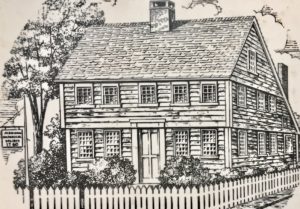
A saltbox in another Connecticut city – the Andrews Homestead as depicted on a collectible ceramic tile by Atlas Crystal Works Inc. – made in England, hand decorated in Tennessee, according to label affixed on the reverse.
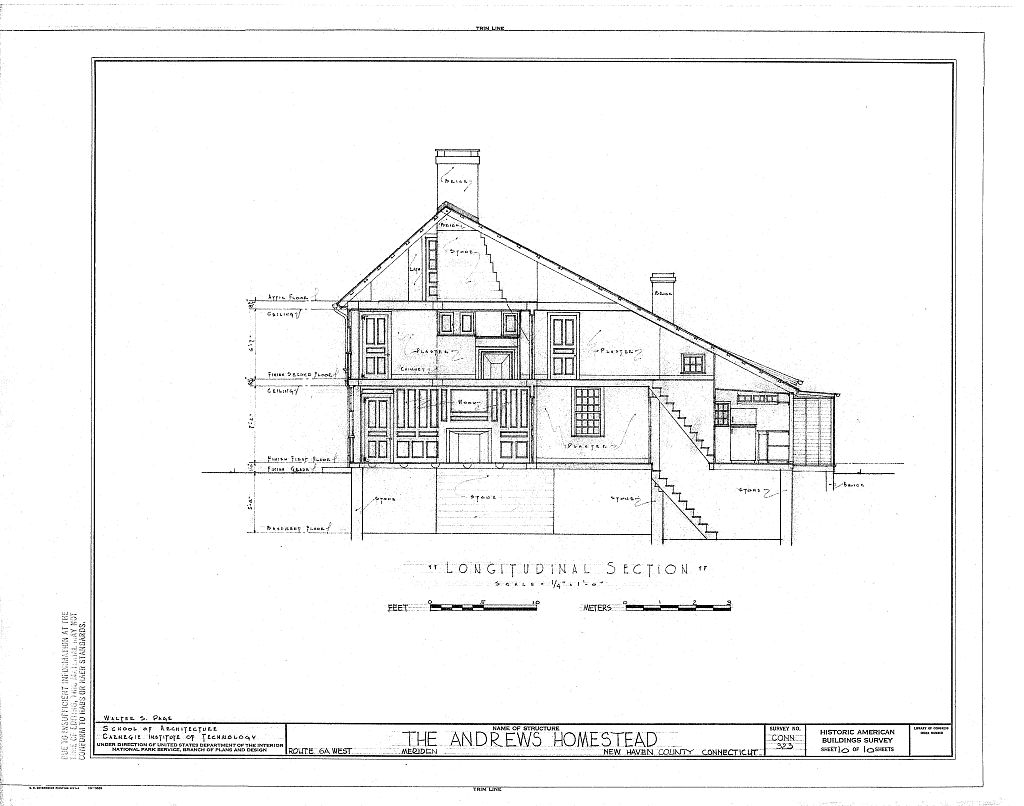
Schematic of a structure. Andrews Homestead, Route 6A West, Meriden, New Haven County, CT. HABS CT-323 (Library of Congress)
Last but not least is a documentary that connects time and makers, collections: The Lake of Scars.
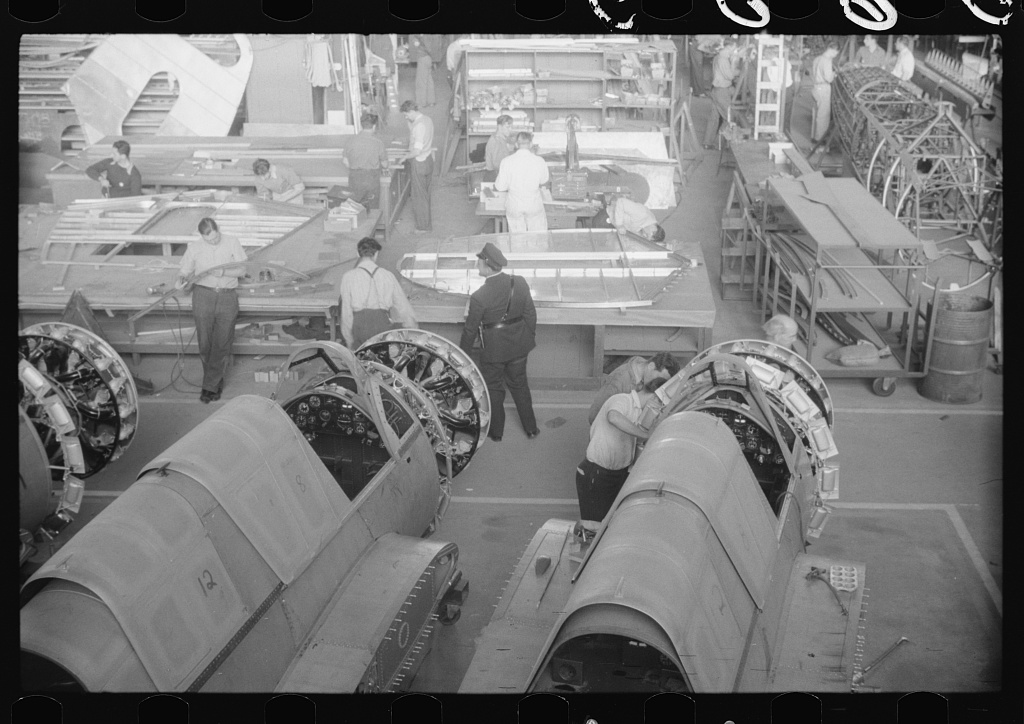
On the factory floor of the Vought-Sikorsky Aircraft Corporation, Stratford, Connecticut. Jack Delano (1914-1997) photographer. Published Nov. 1940. Library of Congress, image linked to series.
Realized. Engineering an idea into reality, then refining that by work, failure, more work.
Igor Sikorsky. His “dream of aviation began at the age of 11 years. That statement of the dream is quoted from Chapter 1 of his autobiography – “The Story of the Winged – S.”
“During the year 1900, at the age of about 11 years, I had a wonderful dream. For several days I lived under the impression of that dream and have always remembered the details.
“I saw myself walking along a narrow, luxuriously decorated passageway. On both sides were walnut doors, similar to the state room doors of a steamer. The floor was covered with an attractive carpet. A spherical electric light from the ceiling produced a pleasant bluish illumination. Walking slowly, I felt a slight vibration under my feet and was not surprised to find that the feeling was different from that experienced on a steamer or on a railroad train. I took this for granted because in my dream I knew that I was on board a large flying ship in the air. Just as I reached the end of the corridor and opened a door to enter a decorated lounge, I woke up.
“Everything was over. The palatial flying ship was only a beautiful creation of the imagination. At that age I had been told that man never produced a successful flying machine and that it was considered impossible.”
“'Impossible' but not to Igor Sikorsky who went on to distinguish himself in three different aeronautical fields – large multi-engine aircraft, transoceanic flying boats and helicopters.”
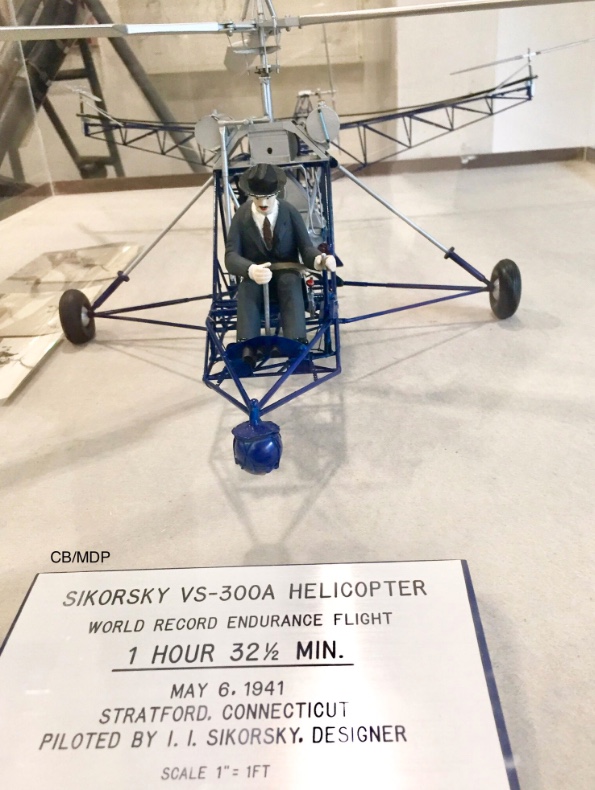
Piloted by I.I. Sikorsky, designer. Part of an exhibit seen during a visit to New England Air Museum.
“The work of a pioneer in science of technique often consists of finding a correct solution, or creating a working mechanism, based on laws that are not yet discovered.” Igor Sikorsky
There is nothing like turning wrenches and OJT to learn engineering and how things work. On a flightline, rescue and recovery, a leaking hoist control panel valve. First project. Much later, a dual start valve that took a team to re-install. Hydraulic forces; an area inside an HH-53H that is known as a broomcloset converting force into motion mechanically. Physics come to life.
As this past season, learning about builders by painting structures. How sited. Why. A human's work over time speaks volumes. There are patterns which unlock understanding. A new exhibit that distills the brilliance of Sikorsky's plethora of ideas made into reality and makes some of those accessible to visitors.
New exhibit highlights Connecticut aviation pioneer Igor I. Sikorsky / https://t.co/gqgOMLapLw @Sikorsky
— NewHavenBiz (@NewHavenBiz) September 30, 2022
Note: For more about East Lyme and the area's industries, Factories, Farms and Fishes Too: Historical Photographs of East Lyme, Connecticut by Elizabeth Hall Kuchta (2010). A portion of this story originally was published March 8, 2017. Since then the idea of telling three-dimensional stories using augmented reality to tour structures is reality. Stay tuned for combining photogrammetry and virtual reality to showcase historic places and interesting architecture with the intertwined history of business, communities, innovation and entrepreneurs across the region. More about the Andrews original farm and history. Indigenous makers and collections found and connections made in Connecticut, across time. This story has been updated.

